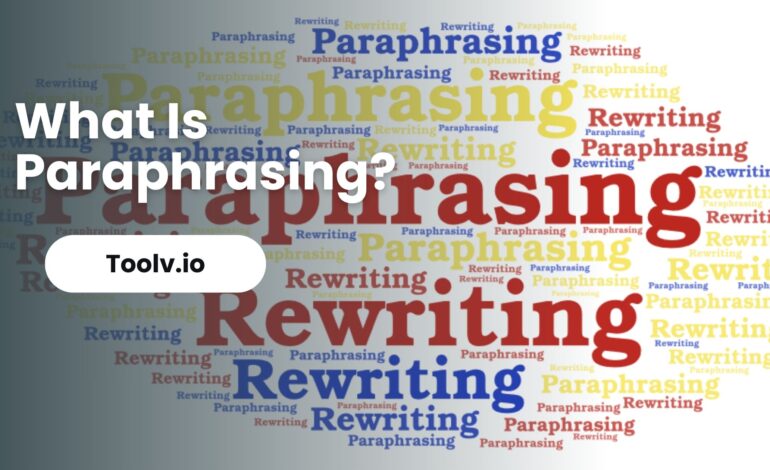What Is Paraphrasing? All You Need To Know!

Paraphrasing is the act of rewording or rephrasing someone else’s ideas or writings into your own words while keeping the original meaning intact. It’s a skill that helps in presenting information in a new way, without copying the source directly.
In this article, we will discuss how paraphrasing works, its importance in various fields, and some helpful software tools that can assist in effective paraphrasing. This knowledge will empower you to use information responsibly and creatively.
What Is Paraphrasing?
Paraphrasing is a way of restating something using different words. It’s like saying the same thing in a new way. This is helpful when you want to make an idea clearer or easier to understand.
Paraphrasing isn’t just changing a few words, it involves completely rewriting the original while keeping the main idea the same. It’s important in writing and speaking to avoid copying exactly what someone else said.
By paraphrasing, you show you understand the idea and can explain it in your own words. It’s a skill that helps in studies, work, and everyday communication.
The Importance of Paraphrasing
Paraphrasing is crucial for effective communication. It allows us to take complex or technical information and put it in simpler terms. By rephrasing, we can explain things in a way that’s easier to understand, especially for those not familiar with the original content.
It also enhances our writing and speaking skills. Paraphrasing forces us to deeply understand the material. We must grasp the core message before we can restate it in our own words.
Moreover, paraphrasing is key in academic and professional settings. It helps avoid plagiarism, showing respect for original ideas. By rephrasing, we contribute our own perspective, making the content unique.

Techniques for Effective Paraphrasing
Effective paraphrasing involves several key techniques. Firstly, read and understand the original text completely. It’s crucial to grasp the main idea and supporting details.
Secondly, use synonyms where possible. Replace words from the original text with words that mean the same thing but are different. This shows you have a good vocabulary and understand the topic.
Finally, change the sentence structure. If the original text uses a particular order or format, try rearranging it. This could mean turning a passive sentence into an active one or combining two short sentences into one.
Examples of Paraphrasing
Paraphrasing means explaining something in new words. It’s like reading a book and then telling a friend what it’s about in your own way. This helps avoid copying directly and shows you really understand.
It’s not just swapping words; it’s about changing how the sentence is built while keeping the original meaning. It’s useful for school projects or work reports. It makes ideas clearer and unique.
Good paraphrasing sticks to the main point without adding new thoughts. It’s like retelling a story but in your own style. This skill is important for sharing knowledge without just repeating someone else’s words.
Example 1
Original: “Global warming is a serious threat to the planet, causing rising sea levels and unpredictable weather patterns.”
Paraphrased: “The planet faces a significant challenge due to global warming, which leads to higher sea levels and inconsistent weather.”
Example 2
Original: “Technology has advanced rapidly, transforming how we communicate and access information.”
Paraphrased: “Advancements in technology have revolutionized our methods of communication and the way we obtain information.”
Example 3
Original: “Eating a balanced diet is essential for maintaining good health and preventing various diseases.”
Paraphrased: “To stay healthy and avoid different illnesses, it’s crucial to consume a variety of nutritious foods.”
Common Mistakes in Paraphrasing
- Copying the Original Text Too Closely: Using too many of the same words or phrases from the original text.
- Changing the Meaning: Altering the original idea or message while trying to paraphrase.
- Adding Personal Opinions: Including personal views or interpretations that were not present in the original text.
- Over-Simplification: Oversimplifying complex ideas, thus losing important details or nuances.
- Forgetting Citations: Not crediting the original source, which can lead to plagiarism.
- Using Complex Language: Attempting to use unnecessarily complex or academic language, which can make the paraphrase difficult to understand.
- Ignoring the Original Structure: Failing to change the sentence structure sufficiently, resulting in a paraphrase too similar to the original.
The Role of Paraphrasing in SEO
Paraphrasing is a key tool in SEO, which stands for Search Engine Optimization. It involves rewriting text in new ways. This helps create unique content. Search engines like Google prefer original material. So, paraphrasing helps websites rank better.
By changing words and sentence structures, paraphrasing avoids plagiarism. It’s like giving the same idea a fresh look. This keeps the content interesting for readers. Plus, it helps websites stay honest and original.
Using paraphrasing, websites can cover similar topics without copying. This is great for SEO. It makes the site more visible online. More visibility means more visitors, which is good for any website.
FAQs
What is paraphrasing?
Paraphrasing is the process of rewording or rephrasing text or speech in your own words while maintaining the original meaning. It involves changing the structure of the sentences and substituting words with synonyms, without altering the original context or intent of the source material.
How does paraphrasing differ from summarizing?
Paraphrasing involves rewriting a specific passage, sentence, or idea in your own words, keeping the same level of detail as the original. In contrast, summarizing involves condensing the main points of a larger piece of text into a brief overview, focusing only on the key themes and omitting detailed examples.
Why is paraphrasing important?
Paraphrasing is important for several reasons. It demonstrates your understanding of the source material, allows you to integrate evidence and support into your writing more seamlessly and originally, helps in avoiding plagiarism, and can make complex information more accessible and clearer to your audience.
What are some tips for effective paraphrasing?
To effectively paraphrase, you should first fully understand the original text. Then, restate the ideas in your own words without looking at the original text. Use synonyms and change the sentence structure.
Conclusion
Paraphrasing is the act of expressing the same ideas or messages in different words. It’s a skill that helps in understanding and communicating concepts effectively.
Toolv.io’s paraphrasing tool is a digital aid that simplifies this process. By inputting text, it rewards content while keeping the original meaning intact. This tool is valuable for enhancing writing and ensuring clarity in communication.
For more information about how to convert text to speech, click our how to convert text to speech post. For free text to speech tools click on our free text to speech tool post.





